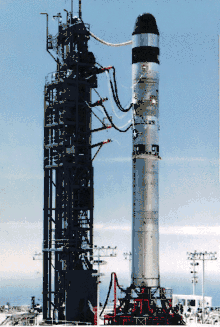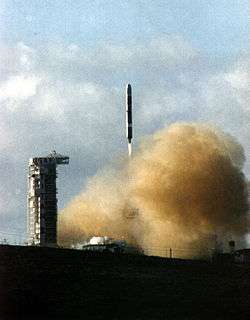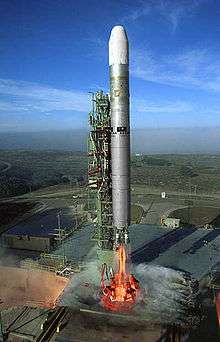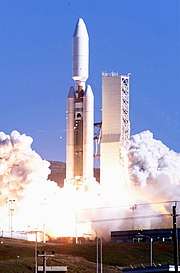Titan 23G
The Titan 23G, Titan II(23)G, Titan 2(23)G or Titan II SLV was an American expendable launch system derived from the LGM-25C Titan II intercontinental ballistic missile. Retired Titan II missiles were converted by Martin Marietta, into which the Glenn L. Martin Company, which built the original Titan II, had merged. It was used to carry payloads for the United States Air Force, NASA and NOAA. Thirteen were launched from Space Launch Complex 4W at the Vandenberg Air Force Base between 1988 and 2003.[1]
 The first Titan 23G prior to launch | |
| Function | Expendable launch system |
|---|---|
| Manufacturer | Martin Marietta |
| Country of origin | United States |
| Size | |
| Height | 31.4 meters (103 ft) |
| Diameter | 3.05 meters (10.0 ft) |
| Mass | 117,020 kilograms (257,980 lb) |
| Stages | Two or Three |
| Capacity | |
| Payload to LEO | 3,600 kilograms (7,900 lb) |
| Payload to Polar LEO | 2,177 kilograms (4,799 lb) |
| Payload to HCO | 227 kilograms (500 lb) |
| Associated rockets | |
| Family | Titan |
| Launch history | |
| Status | Retired |
| Launch sites | Vandenberg SLC-4W |
| Total launches | 13 |
| Successes | 12 |
| Failures | 1 |
| First flight | 5 September 1988 |
| Last flight | 18 October 2003 |
| Notable payloads | Clementine |
| First stage | |
| Engines | LR-87 (one engine with two combustion chambers) |
| Thrust | 1,900 kilonewtons (430,000 lbf) |
| Specific impulse | 258 sec |
| Burn time | 156 seconds |
| Fuel | N2O4 / Aerozine 50 |
| Second stage | |
| Engines | 1 LR-91 |
| Thrust | 445 kilonewtons (100,000 lbf) |
| Specific impulse | 316 sec |
| Burn time | 180 seconds |
| Fuel | N2O4 / Aerozine 50 |
| Third stage (Optional) – Star-37XFP-ISS | |
| Engines | 1 Solid |
| Thrust | 38.03 kilonewtons (8,550 lbf) |
| Specific impulse | 290 sec |
| Burn time | 67 seconds |
| Fuel | Solid |
| Third stage (Optional) – Star-37S | |
| Engines | 1 Solid |
| Specific impulse | 287 sec |
| Fuel | Solid |
Titan 23G rockets consisted of two stages burning liquid propellant. The first stage was powered by one Aerojet LR87 engine with two combustion chambers and nozzles, and the second stage was propelled by an LR91. On some flights, the spacecraft included a kick motor, usually the Star-37XFP-ISS; however, the Star-37S was also used.[1]
A contract to refurbish fourteen Titan II missiles to the Titan 23G configuration was awarded to Martin Marietta in January 1986. The first launch occurred on 5 September 1988, carrying a classified payload for the US National Reconnaissance Office. Thirteen were launched, with the fourteenth going to the Evergreen Aviation Museum.[2] The final flight occurred on 17 October 2003, carrying a DMSP satellite.[3]
During refurbishment, the forward structure of the second stage was modified with the addition of a payload attachment fitting to attach the payload to the rocket, and installing a payload fairing to protect it during launch. The engines were refurbished, and the rockets' guidance and control systems were upgraded by Delco Electronics.
The former Titan IIIB pad at Vandenberg, SLC-4W, was modified to accommodate the Titan 23G, and was used for all thirteen launches.
Launch history
All launches of Titan II(23)G rockets took place from Space Launch Complex 4W at Vandenberg Air Force Base.
| Date/Time (UTC) | Serial number | Third Stage | Payload | Outcome | Remarks | |
|---|---|---|---|---|---|---|
| Rocket | Stages | |||||
| 5 September 1988 09:25 |
G-1 | B-98/56 | None | USA-32 (Bernie) | Success | |
| 6 September 1989 01:48 |
G-2 | B-75/99 | None | USA-45 (Bernie) | Success | Spacecraft failed immediately after launch |
| 25 April 1992 08:53 |
G-3 | B-102 | None | USA-81 (Bernie) | Success | |
| 5 October 1993 17:56 |
G-5 | B-65 | None | Landsat 6 | Success | Spacecraft Star-37 failure, failed to achieve orbit[4] |
| 25 January 1994 16:34 |
G-11 | B-89/67 | None | Clementine DSPSE-ISA |
Success | |
| 4 April 1997 16:47 |
G-6 | B-106 | None | USA-131 (DMSP-5D2 F-14) | Success | |
| 13 May 1998 15:52:04 |
G-12 | B-84/80 | None | NOAA-15 (NOAA-K) | Success | Included oxidizer (N2O4) tank from Titan II B-72 |
| 20 June 1999 02:15:00 |
G-7 | B-99/75 | None | QuikSCAT | Success | |
| 12 December 1999 17:36:01 |
G-8 | B-94/44 | None | USA-147 (DMSP-5D3 F-15) | Success | |
| 21 September 2000 10:22 |
G-13 | B-96/39 | None | NOAA-16 (NOAA-L) | Success | |
| 24 June 2002 18:23:04 |
G-14 | B-71/72 | None | NOAA-17 (NOAA-M) | Success | Included oxidizer (N2O4) tank from Titan II B-92 |
| 6 January 2003 14:19 |
G-4 | B-105 | None | Coriolis | Success | |
| 18 October 2003 16:17 |
G-9 | B-107 | None | USA-172 (DMSP-5D3 F-16) | Success | Final Titan II launch |
A fourteenth rocket, G-10, based on Titan II B-108, but incorporating an oxygen tank from B-80, was not launched and is preserved at the Evergreen Aviation & Space Museum in McMinnville, Oregon. The remaining 42 Titan II missiles were stored at Davis-Monthan AFB with most being broken up for salvage. Four were transferred to museums.
 01 Titan-23G01 BERNIE-1 ELINT satellite
01 Titan-23G01 BERNIE-1 ELINT satellite 04 Titan-23G05 LANDSAT-6
04 Titan-23G05 LANDSAT-6 05 Titan-23G11 CLEMENTINE
05 Titan-23G11 CLEMENTINE 06 Titan-23G06 DMSP-F14
06 Titan-23G06 DMSP-F14 07 Titan-23G12 NOAA-K
07 Titan-23G12 NOAA-K 08 Titan-23G07 QuickSCAT
08 Titan-23G07 QuickSCAT 09 Titan-23G08 DMSP-F15
09 Titan-23G08 DMSP-F15 10 Titan-23G13 NOAA-L
10 Titan-23G13 NOAA-L 11 Titan-23G14 NOAA-M
11 Titan-23G14 NOAA-M 12 Titan-23G04 CORIOLIS
12 Titan-23G04 CORIOLIS 13 Titan-23G09 DMSP-F16
13 Titan-23G09 DMSP-F16 Titan-II B-108 in 1988 became 23G10 program spare
Titan-II B-108 in 1988 became 23G10 program spare
See also
References
| Wikimedia Commons has media related to Titan 23G. |
- Krebs, Gunter. "Titan-2". Gunter's Space Page. Retrieved 2009-04-29.
- Kyle, Ed (2009-04-14). "Titan 23G Data Sheet". Space Launch Report. Retrieved 2009-04-29.
- Wade, Mark. "Titan". Encyclopedia Astronautica. Retrieved 2009-04-29.
- Wade, Mark. "Landsat 6". Encyclopedia Astronautica. Retrieved 24 January 2014.
